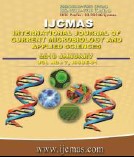


 National Academy of Agricultural Sciences (NAAS)
National Academy of Agricultural Sciences (NAAS)

|
PRINT ISSN : 2319-7692
Online ISSN : 2319-7706 Issues : 12 per year Publisher : Excellent Publishers Email : editorijcmas@gmail.com / submit@ijcmas.com Editor-in-chief: Dr.M.Prakash Index Copernicus ICV 2018: 95.39 NAAS RATING 2020: 5.38 |
Roselle (Hibiscus sabdariffa L.) is an important commercial crop among bast fibres in India after jute and till date almost nil efforts were made in terms of crop improvement aspects pertaining to seed yield in roselle as it majorly utilized as fibre crop. To acquire first hand information on seed yield and its contributing traits, a set of sixty genotypes of roselle have been used to study the genetic variability, heritability, correlation and path analysis for seed yield and its contributing traits during 2013 and 2014 at three different agro-climatic zones of India. Phenotypic as well as genotypic coefficients of variability (PCV and GCV) were high for the trait pods per plant and seed yield; whereas, medium for base diameter and low for days to 50% flowering. Medium heritability coupled with high expected genetic gain was observed for pods per plant and seed yield. Seed yield was found to be positively and highly significant with pods per plant, base diameter and plant height both at genotypic and phenotypic levels; whereas, only at phenotypic level for seeds per pod and test weight. Partitioning of correlation coefficients of various components direct effects upon seed yield into direct and indirect contributions revealed that pods per plant has maximum direct effect upon seed yield followed by seeds per pod and test weight at both levels. High positive correlation coefficients for plant height and base diameter were due to indirect effects of pods per plant. Hence, selection for the traits pods per plant, seeds per pod, plant height and base diameter may be successful for seed yield improvement in roselle.
 |
 |
 |
 |
 |